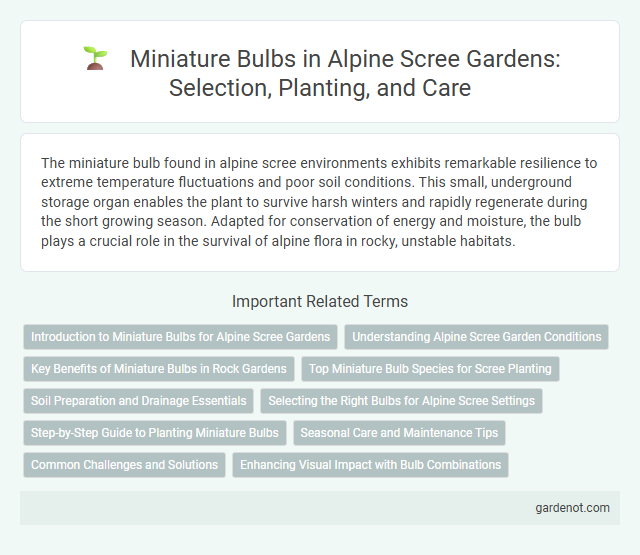The miniature bulb found in alpine scree environments exhibits remarkable resilience to extreme temperature fluctuations and poor soil conditions. This small, underground storage organ enables the plant to survive harsh winters and rapidly regenerate during the short growing season. Adapted for conservation of energy and moisture, the bulb plays a crucial role in the survival of alpine flora in rocky, unstable habitats.
Introduction to Miniature Bulbs for Alpine Scree Gardens
Miniature bulbs such as Crocus, Snowdrops (Galanthus), and Chionodoxa thrive in alpine scree gardens due to their compact size and early blooming characteristics. These bulbs adapt well to the well-drained, rocky soil conditions typical of scree environments, providing vibrant color in spring. Their low maintenance requirements and resilience to harsh weather make them ideal for enhancing the visual appeal of alpine scree landscapes.
Understanding Alpine Scree Garden Conditions
Miniature bulbs thrive in alpine scree gardens by adapting to well-drained, rocky soil with excellent aeration and minimal organic matter. These bulbs require cold stratification periods to break dormancy, mimicking natural alpine temperature fluctuations. Understanding the drainage and temperature dynamics of alpine scree is crucial for successfully cultivating miniature bulb species in these challenging environments.
Key Benefits of Miniature Bulbs in Rock Gardens
Miniature bulbs, such as crocuses and scillas, thrive in alpine scree environments, offering vibrant spring blooms that enhance rock garden aesthetics. Their compact size and early flowering period provide continuous color while requiring minimal maintenance and water. These bulbs adapt well to well-drained, rocky soils, promoting biodiversity and attracting pollinators in alpine garden settings.
Top Miniature Bulb Species for Scree Planting
Top miniature bulb species for alpine scree planting include Crocus tommasinianus, known for its early spring blooms and adaptability to rocky, well-drained soils, and Chionodoxa luciliae, which thrives in alpine conditions with minimal moisture. Scilla bifolia displays vibrant blue flowers ideal for scree gardens, while Galanthus nivalis (snowdrop) provides resilience in cold, harsh environments typical of alpine scree habitats. These species offer compact growth forms, strong root systems, and high tolerance to temperature fluctuations, making them excellent choices for scree planting.
Soil Preparation and Drainage Essentials
Miniature bulbs thriving in alpine scree require well-drained, gritty soil that mimics their natural rocky habitat, promoting root health and preventing waterlogging. Incorporating coarse sand, gravel, or crushed stone into the planting medium ensures optimal drainage and aeration crucial for miniature bulb development. Proper soil preparation includes creating a shallow planting depth and avoiding compacted substrates to facilitate swift root establishment and moisture regulation.
Selecting the Right Bulbs for Alpine Scree Settings
Choosing the right miniature bulbs for alpine scree gardens involves prioritizing species that thrive in rocky, well-drained soils with high sunlight exposure. Bulbs such as dwarf crocus, alpine snowdrop, and miniature narcissus exhibit excellent drought tolerance and compact growth habit suitable for scree environments. Selecting bulbs with early spring bloom times enhances seasonal interest while ensuring they can withstand temperature fluctuations typical of alpine conditions.
Step-by-Step Guide to Planting Miniature Bulbs
Start by selecting well-draining soil typical of Alpine scree environments, ensuring it replicates native rocky and gritty conditions. Plant miniature bulbs at a depth twice their size, spacing them 2-3 inches apart for optimal growth and airflow. Water sparingly to mimic natural precipitation, avoiding waterlogging which can cause bulb rot in these specialized alpine settings.
Seasonal Care and Maintenance Tips
Miniature bulbs in alpine scree require well-drained soil and exposure to full sun to thrive during their growing season. Water sparingly in early spring and reduce moisture once foliage begins to die back, preventing bulb rot. Mulching with fine gravel helps maintain consistent temperature and moisture levels throughout seasonal shifts, promoting healthy growth and bloom year after year.
Common Challenges and Solutions
Miniature bulbs in alpine scree environments often face challenges such as limited water retention, extreme temperature fluctuations, and poor nutrient availability due to the rocky substrate. To overcome these issues, selecting species adapted to drought and temperature stress, along with strategic mulching and careful soil amendment, enhances bulb survival and growth. Ensuring adequate drainage while retaining some moisture helps maintain optimal conditions for miniature bulb development in scree habitats.
Enhancing Visual Impact with Bulb Combinations
Miniature bulbs like crocuses and snowdrops thrive in alpine scree, creating vibrant color contrasts against rocky textures. Combining varied bulb species enhances visual impact by introducing layered bloom times and diverse hues, which attract pollinators and extend seasonal interest. Strategic placement of bulbs in clusters amplifies their presence, transforming sparse scree landscapes into dynamic floral displays.
Miniature bulb Infographic

 gardenot.com
gardenot.com